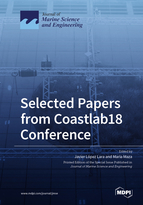Selected Papers from Coastlab18 Conference
A special issue of Journal of Marine Science and Engineering (ISSN 2077-1312). This special issue belongs to the section "Coastal Engineering".
Deadline for manuscript submissions: closed (20 May 2019) | Viewed by 57168
Special Issue Editors
Interests: coastal engineering; wave and structure interaction; CFD modelling; surf zone hydrodynamics; harbour agitation; wave-plant interaction; coastal structures
Interests: flow-ecosystem interaction; natural based solutions in coastal protection and management; computational fluid mechanics; water waves hydrodynamics; wave and structure interaction
Special Issue Information
Dear Colleagues,
The 7th International Conference on the Application of Physical Modelling in Coastal and Port Engineering and Science, Coastlab18, organised in May 2018 by the Institute of Environmental Hydraulics of Cantabria (Spain), IHCantabria, provides a stimulating and enriching forum to discuss the latest developments in physical modelling applied to coastal and port engineering and coastal science on the following conference themes:
- Coastal hydrodynamics, coastal processes
- Sediment transport, erosion, sedimentation, scour
- Coastal flooding, flood prevention, shore protection
- Coastal and ocean structures, breakwaters, revetments
- Wave-structure interactions, loading, response
- Wave run-up and overtopping
- Industrial outfalls, mixing, water quality
- Ports, marine terminals, navigation, ship motions
- Wave and tidal energy
- Laboratory technologies, measurement systems
- Wave synthesis, generation and analysis
- Scale effects and uncertainty analysis
- Combined physical and numerical modelling
- Extreme events-assessment and mitigation
- Tsunami hydrodynamics, impacts and mitigation
- Climate change impacts and adaptation
- Physical modelling case studies
- Coastal field measurements and monitoring
- Natural based solutions and eco-engineering
Coastlab18 is organized under the auspices of the International Association of Hydro-Environment Engineering and Research (IAHR). This Special Issue presents a selection of papers from the conference. The papers give insight on theoretical and practical aspects related with physical modelling in the field of coastal and ocean engineering. Coastal and ocean structures, breakwaters, revetments, laboratory technologies, measurement systems, coastal field measurement and monitoring, combined physical and numerical modelling, physical modelling case studies, tsunami and coastal hydrodynamics are the main topics covered in this Special Issue.
Dr. Javier L. Lara
Dr. Maria Maza
Guest Editors
Manuscript Submission Information
Manuscripts should be submitted online at www.mdpi.com by registering and logging in to this website. Once you are registered, click here to go to the submission form. Manuscripts can be submitted until the deadline. All submissions that pass pre-check are peer-reviewed. Accepted papers will be published continuously in the journal (as soon as accepted) and will be listed together on the special issue website. Research articles, review articles as well as short communications are invited. For planned papers, a title and short abstract (about 100 words) can be sent to the Editorial Office for announcement on this website.
Submitted manuscripts should not have been published previously, nor be under consideration for publication elsewhere (except conference proceedings papers). All manuscripts are thoroughly refereed through a single-blind peer-review process. A guide for authors and other relevant information for submission of manuscripts is available on the Instructions for Authors page. Journal of Marine Science and Engineering is an international peer-reviewed open access monthly journal published by MDPI.
Please visit the Instructions for Authors page before submitting a manuscript. The Article Processing Charge (APC) for publication in this open access journal is 2600 CHF (Swiss Francs). Submitted papers should be well formatted and use good English. Authors may use MDPI's English editing service prior to publication or during author revisions.
Keywords
- Laboratory technologies
- Measurement systems
- Coastal and ocean structures
- Combined physical and numerical modelling
- Physical modelling case studies
- Scale effects and uncertainty analysis
- Wave synthesis, generation and analysis







